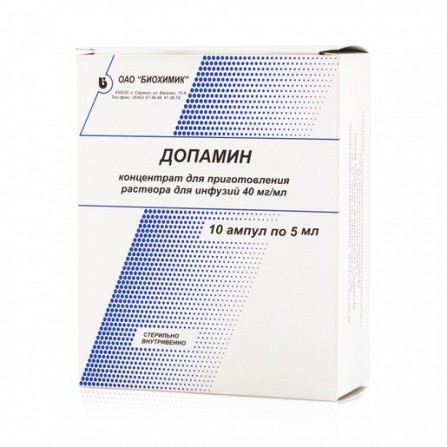Dopamine g x Concentrate for infusions 40mg ml 5ml N10
Condition: New product
1000 Items
Rating:
Be the first to write a review!

More info
Active ingredients
Dopamine
Release form
Concentrate
Composition
In 1 ml. concentrate: dopamine hydrochloride 40 mg. Excipients: sodium disulfite - 5 mg, hydrochloric acid solution 0.1 M - to pH 3.5-4.0, water d / and - to 1 ml.
Pharmacological effect
Cardiotonic and hypertensive agent. The dopamine receptor agonist is their endogenous ligand. At low doses (0.5–3 mcg / kg / min), it acts predominantly on dopamine receptors, causing dilation of the renal, mesenteric, coronary and cerebral vessels. Due to the specific effect on peripheral dopamine receptors, it reduces the resistance of renal vessels, increases blood flow in them, as well as glomerular filtration, excretion of sodium ions and diuresis. Mesenteric vessels are also dilated (thus, the effect of dopamine on the renal and mesenteric vessels differs from that of other catecholamines). In low and medium doses (2-10 mcg / kg / min), it stimulates postsynaptic? 1-adrenoreceptors, which causes a positive inotropic effect and an increase in minute blood volume. Systolic blood pressure and pulse pressure may increase. however, diastolic blood pressure does not change or slightly increases. OPSS usually does not change. Coronary blood flow and myocardial oxygen consumption, as a rule, increase. At high doses (10 mcg / kg / min or more), stimulation of α1-adrenoreceptors prevails, causing an increase in OPSS, heart rate and narrowing of the renal vessels (the latter may decrease previously increased renal blood flow and diuresis). Due to an increase in the minute volume of blood and OPS, both systolic and diastolic blood pressure increases. The beginning of the therapeutic effect is within 5 minutes on the background of intravenous administration and continues for 10 minutes.
Indications
Shock of various genesis (cardiogenic, postoperative, infectious-toxic, anaphylactic, hypovolemic / only after restoring BCC /). Acute cardiovascular insufficiency of various origins, low cardiac output syndrome in cardiac patients, hypotension to increase diuresis in case of poisoning.
Contraindications
Hypertrophic obstructive cardiomyopathy, pheochromocytoma, ventricular fibrillation, hypersensitivity to dopamine.
Use during pregnancy and lactation
In pregnancy and lactation (breastfeeding), dopamine is used only in cases where the intended benefit to the mother outweighs the potential risk to the fetus or child.
Side effects
On the part of the cardiovascular system: tachycardia or bradycardia, chest pain, increase or decrease in blood pressure, conduction disturbances, expansion of the QRS complex, vasospasm, increase in end-diastolic pressure in the left ventricle. when used in high doses - ventricular or supraventricular arrhythmias. On the part of the digestive system: nausea, vomiting, bleeding from the gastrointestinal tract. From the nervous system: headache, anxiety, restlessness, tremor of the fingers. Metabolism: polyuria. Allergic reactions: in patients with bronchial asthma - bronchospasm, shock. Local reactions: when dopamine gets under the skin - necrosis of the skin, subcutaneous tissue. Other: dyspnea, azotemia, piloerection, with the introduction in low doses - polyuria.
special instructions
On the part of the cardiovascular system: tachycardia or bradycardia, chest pain, increase or decrease in blood pressure, conduction disturbances, expansion of the QRS complex, vasospasm, increase in end-diastolic pressure in the left ventricle. when used in high doses - ventricular or supraventricular arrhythmias. On the part of the digestive system: nausea, vomiting, bleeding from the gastrointestinal tract. From the nervous system: headache, anxiety, restlessness, tremor of the fingers. Metabolism: polyuria. Allergic reactions: in patients with bronchial asthma - bronchospasm, shock. Local reactions: when dopamine gets under the skin - necrosis of the skin, subcutaneous tissue. Other: dyspnea, azotemia, piloerection, with the introduction in low doses - polyuria.




